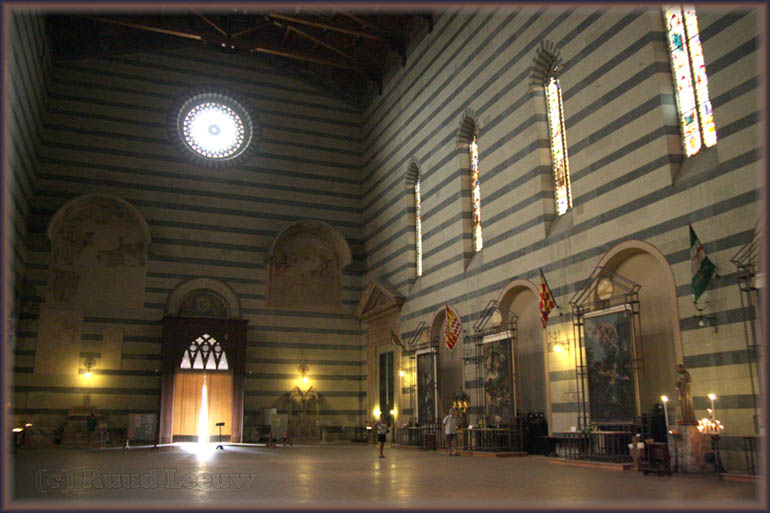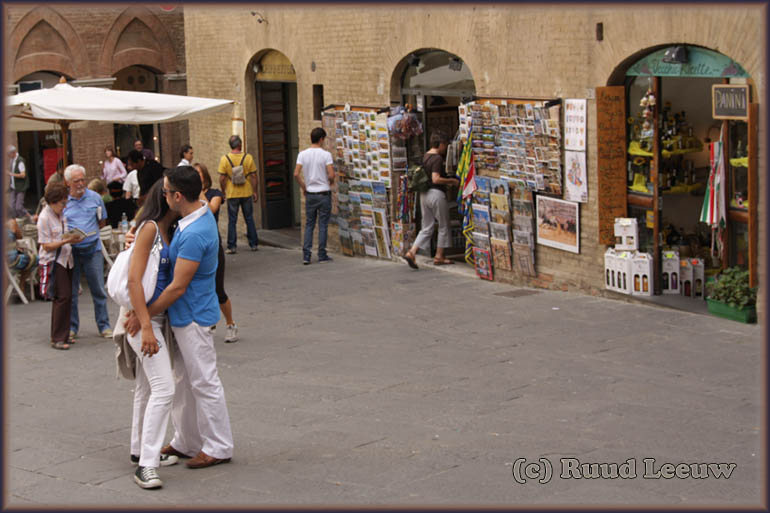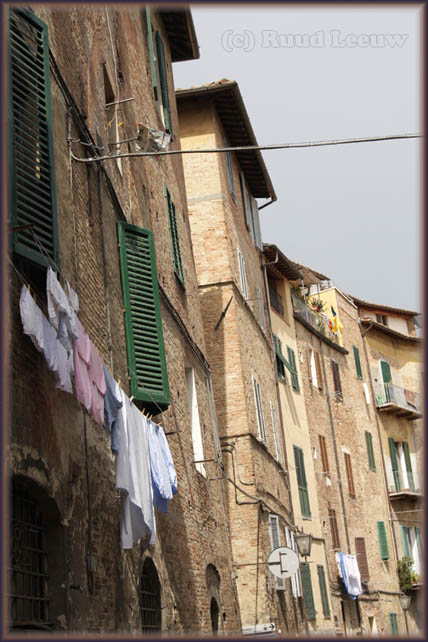 Photos © Ruud Leeuw
Photos © Ruud Leeuw Photos © Ruud Leeuw
Photos © Ruud Leeuw
In September we drove down to Italy and visited some cities in this beautiful country. Click on the thumbnail images to view a larger image |
After we parked our car, we made our way to a nearby escalator (a tourist-friendly facility, in 4 stages we were lifted to the elevated level of the center of town. |
Today the Franciscan convent to the right of the church and the Renaissance cloister are occupied by the Law Faculty and Department Library of the University of Siena. |
 The lateral walls are adorned with early Quattrocento Senese School fresco decorations of exceptional quality. The interior facade is decorated with two frescoes, one by Sodoma and the other by Sassetta. |
| Siena, like other Tuscan hill towns, was first settled in the time of the Etruscans (ca. 900 BC to 400 BC) when it was inhabited by a tribe called the Saina. The Etruscans were an advanced people who changed the face of central Italy through their use of irrigation to reclaim previously unfarmable land, and their custom of building their settlements in well-defended hill-forts. Siena did not prosper under Roman rule. It was not sited near any major roads and therefore missed out on the resulting opportunities for trade. Its insular status meant that Christianity did not penetrate until the 4th century AD, and it was not until the Lombards invaded Siena and the surrounding territory that it knew prosperity. Siena prospered as a major centre of money lending and an important player in the wool trade during the 1100s. Siena's university, founded in 1203 and famed for its faculties of law and medicine, is still among the most important Italian universities. Siena rivalled Florence in the arts through the 13th and 14th centuries. Emperor Charles V put a Spanish garrison in Siena. The citizens expelled it in 1552, allying with France, this was unacceptable for Charles and he sent his general Gian Giacomo Medici to lay siege to it with a Florentine-Imperial army... The Sienese government entrusted its defence to Piero Strozzi. When the latter was defeated at the Battle of Marciano (August 1554), any hope of relief was lost. After 18 months of resistance, it surrendered to Florence on April 17, 1555, marking the end of the Republic of Siena. The new Spanish King Philip, owing huge sums to the Medici, ceded it (apart a series of coastal fortress annexed to the State of Presidi) to the Grand Duchy of Tuscany, to which it belonged until the unification of Italy in the 19th century. The picturesque city remains an important cultural centre, especially for humanist disciplines. The historic centre of Siena has been declared by UNESCO a World Heritage Site. [Source: WIKIPEDIA] |
| After our visit to this impressive church, we went out into the streets of Siena.. |
 Piazza del Campo...
Piazza del Campo...Built over an area that was once an open field, hence its name ‘campo’, Piazza del Campo is one of the world’s finest examples of secular architecture and is the precise meeting point of the three hills on which Siena is built. The earliest documented mention of the area dates back to 1169, when the field is listed as having been acquired by the community of Siena as an area to be used for fairs, markets and public celebrations during the rule of the Governo dei Ventiquattro (1236-1270). The semi-circular area occupied by Piazza del Campo covers a difficult and irregular terrain, making this masterpiece of harmony and elegance all the more remarkable an achievement. The buildings that surround the square have all been built according to specifications laid down as early as 1297, which stipulated certain strict limitations of height and adornment. The church of Saint Peter and Paul, which faced onto the square, was in fact demolished because it did not comply with these rules... Just like in the Middle Ages, Piazza del Campo is the centre of Siena. All the town’s main streets lead into the square, which stands on the boundary between the Terzo di Città and the Terzo di San Martino quarters.  Through the centuries this square has witnessed all of the city’s major historical events and has been the backdrop to a host of public events and games, from the Giochi dell’Elmora to the Pugna or the Bufale race. Today it is perhaps best known for the Palio, held each year on July 2nd and August 16th – a precipitous horse race. [Sienna Online] Through the centuries this square has witnessed all of the city’s major historical events and has been the backdrop to a host of public events and games, from the Giochi dell’Elmora to the Pugna or the Bufale race. Today it is perhaps best known for the Palio, held each year on July 2nd and August 16th – a precipitous horse race. [Sienna Online]  The crowds of tourists made me feel uncomfortable, it felt like this town was overrun by tour groups. On this townsquare it doesn't show that much but in those narrow streets around it... aaarggh! |
 |
| Siena's cathedral, the Duomo, built in the 12th century, is one of the great examples of Italian romanesque architecture. Its main façade was completed in 1380. It was originally intended to be the largest cathedral in existence. After the completion of the transept and the building of the east wall (which still exists and may be climbed by the public via an internal staircase) the money ran out and the rest of the cathedral was abandoned... [WIKIPEDIA] The crowds standing in line, waiting to get in, took our appetite away for a visit. maybe some other day. |
 Back to the side streets, away from the crowds |
 Some houses show their age, esspecially high up.. |
Our lunch, a Tuscan speciality |
 I would say this is typical Italian... |
But this too!  |
| Links: Siena Online Wikipedia |
|